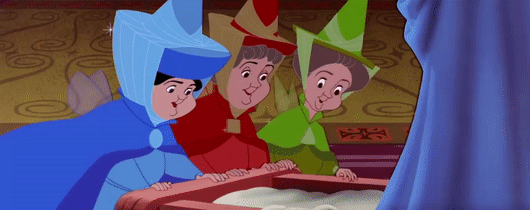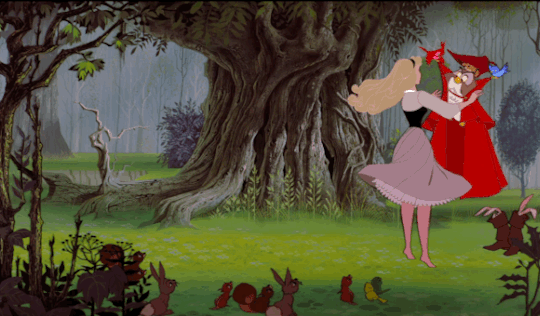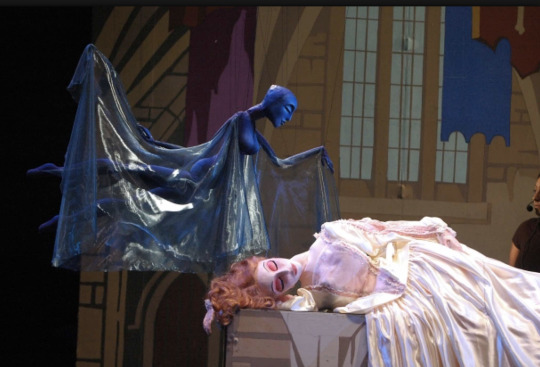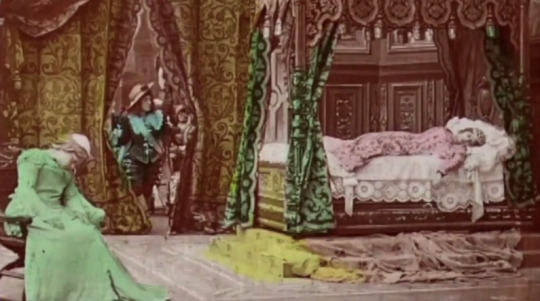Text
How to Play as Aurora in DnD 5e

Aurora is the protagonist of Disney’s 1959 animated classic Sleeping Beauty. Despite having very little screen time, only appearing for 18 minutes of the entire screen time, and havine one of the fewest number of lines in a Disney film, Aurora is surprisingly easy to mold onto a Dungeons and Dragons character in 5th edition, and the updates provided by Tasha’s Cauldron of Everything only made it easier. So, let’s take a Garland Waltz through the glen in the forest to see how Aurora can be played in 5th Edition Dungeons and Dragons.

For her race, Aurora is not an ordinary human. She was given three fey gifts and a curse on the day of her christening. That magic would have altered Aurora making her a Variant Human. From Flora’s gift of Beauty, we’ll give her +1 Charisma, and from Flaura’s gift of song, we’ll use her free skill to give her proficiency with Performance checks. For her second stat, we’ll increase her Wisdom by +1. For her free feat, the Fey Touched feat is what makes her a Variant Human. She gains +1 to her Wisdom score, and adds the spells Misty Step and one 1st level enchantment or divination spell of her choosing. Command, Heroism, and Sleep are three appropriate spells she can’t get from her spell list.

For Aurora’s background, there’s a bit of uncertainty. She is a princess, making an easy fit for the Noble background, but Aurora only learns that she is a princess on the day before her 16th birthday. It’s hardly the circumstances she was raised in. This leaves either Hermit or Outlander as the most fitting backgrounds for her, as they both live in the forest as recluses. Hermits get Medicine and Religion, Outlanders get Athletics and Survival. We see Aurora go foraging for wild berries, and knowing not to eat poison berries is a survival check, so we’ll chalk her up as an Outlander.

CLASS
CIRCLE OF DREAMS DRUID
This subclass is a perfect fit for Aurora. Staring with 2nd level, she gains the Balm of the Summer Court which lets her pool her fey magic to heal others. At 6th level, she can cloak the place she’s sleeping in. Flavor this as her throwing up a wall of thorns, and she’ll sleep soundly protected by fey magic. At 10th level, she’s able to open magical doorways and teleport with her magic. If you want to invoke Kingdom Hearts, you could even say she uses her Princess of Heart powers to open doorways between worlds. Finally, at 14th level, Aurora gains the ability to transmit messages while she dreams, or walk into other people’s dreams, allowing her to deliver messages from the other side of the world to her allies, making sure she can warn people of Maleficent’s plans long before she could ever hope to reach them. But surely, the wildshaping is a problem? Aurora can’t turn into animals? That’s true, but Tasha’s gave us an answer to that. Rather than wildshaping, Aurora can use her wildshape points to instead call upon a Wild Companion, which summons fey in the forms of beasts to aid her, allowing Aurora to be flanked by fairies/animal companions in battle.
While not mandatory, a 1 level dip into Life Domain Cleric can improve Aurora’s healing abilities if you want to bolster that aspect of her build. Since the final ASI as a Druid will come at level 19, she’ll have a level to spare. She’d also get the chance to pick up a few good Cleric spells to boot such as Command, Guiding Bolt, or Sanctuary.

SIDEKICK
PIXIE PRODIGY SPELLCASTER
Tasha’s introduced the sidekick feature which allows for a simpler character build to accompany PCs in a campaign. Your sidekick can be any creature type with any CR of ½ or lower. To invoke the Good Fairies of Flora, Fauna, and Merryweather, we’ll give Aurora a Pixie. Pixies are small fey with innate spellcasting which it casts with Charisma. The Pixie can be made a Prodigy Spellcaster which gives it access to the Bard and Warlock spell list, and has it cast with Charisma. Because both Bards and Druids have healing spells, that allows them to share the burden of designated team heal bots.

Aurora’s Spell List
Cantrips Create Bonfire Frostbite Mold Earth Thorn Whip
1st Level Charm Person Cure Wounds Entangle Faerie Fire Sleep
2nd Level Animal Messenger Healing Spirit Lesser Restoration Misty Step Summon Beast
3rd Level Aura of Vitality Call Lightning Conjure Animals Summon Fey
4th Level Conjure Woodland Beings Grasping Vine Ice Storm
5th Level Greater Restoration Mass Cure Wounds Wrath of Nature
6th Level Conjure Fey Heal Wall of Thorns
7th Level Fire Storm Plane Shift
8th Level Antipathy/Sympathy
9th Level True Resurrection
If you choose to add the 1 level of Cleric, change Cure Wounds into one of the 6 Cleric spells Aurora can prepare, and then add the following from the Cleric spell list. Cleric 1st Level Command Cure Wounds Detect Magic Guiding Bolt Shield of Faith Sanctuary

At first, I didn’t want to give Aurora too many damaging spells because it seemed out of character for someone so passive, but then I realized that would make playing her a bit boring. So I compromised and made her list mostly utility, healing, and general support, but added in elemental magic to invoke Kingdom Hearts and the three main types of magic used by keyblade wielders: Fire, Blizzard, and Thunder. It’s also why she can cast Plane Shift, to return the heartless to their own dimension. If you’d rather build Aurora as a support caster, that’s perfectly fine, but I didn’t want her to seem too boring to play as, having no strong damaging spells with which to actually help her party in combat.
188 notes
·
View notes
Text
Sleeping Beauty Spring: "La Bella Dormente nel Bosco" ("The Sleeping Beauty in the Wood") (1922 Italian opera by Ottorino Respighi)

Name any famous story, and it's almost certain to have been adapted as an opera, whether or not that opera is often performed. Here we find an Italian operatic Sleeping Beauty, with a libretto by Gian Bistolfi, and music by the renowned composer Ottorino Respighi, best known for his tone poems Fountains of Rome, Pines of Rome, and Roman Festivals. It was originally conceived and performed as a marionette opera, with the story enacted by puppets while the singers sang from offstage. While rarely performed today, it does have occasional revivals, some with singing actors performing the roles onstage as in any other opera, and others with marionettes. One complete sound recording is also commercially available, as is a filmed performance from the Teatro Lirico di Cagliari.
Divided into three acts, but fairly short at an hour and forty minutes long, this opera follows the familiar plot of the fairy tale, yet with interesting creative embellishments. Act I opens with an atmospheric nature scene where a nightingale, a cuckoo, and a chorus of frogs sing their evening songs, before the King and Queen's ambassador arrives in search of fairies to attend the newborn Princess's christening, and seven fairies heed his call. At the christening, the villainous Green Fairy curses the Princess to prick her finger at age twenty rather than fifteen or sixteen (some productions of Tchaikovky's ballet make the same change), and not to die, but to sleep forever. Twenty years later, in the old spinning woman's tower, the spindle itself is sentient and sings, as does a cat: the Princess dances a cheerful dance with the two of them, but when she pricks her finger, the spindle gloatingly reveals itself as an agent of the Green Fairy. The following scene begins comically, with pompous doctors trying to diagnose the sleeping Princess's "illness," but then gives way to lamentations by the King, the Queen, and their court. That is, until the kindly Blue Fairy arrives to put them all to sleep as well, and only now does she alter the curse so that it will break when the Princess receives "the kiss of love." In place of the traditional briars or thick forest surrounding the castle, giant spiders weave an enormous web around the castle to protect it.
Act III reveals an especially unusual and quirky change from traditional versions of the story. The Princess and her court have slept for three hundred years rather than just one century, and the action now takes place in the 1920s of the opera's premiere. The entourage of Prince Aprile (yes, his name means "April" – the libretto is full of springtime imagery) includes a club of rich Americans led by the comical "Mr. Dollar Cheque," who resolves to buy the sleeping Princess after they learn her story from a woodcutter. But Prince Aprile takes a more romantic approach and battles the last of the monstrous spiders, causing the web to fall away, and then wakes the Princess with a kiss. After the lovers sing a romantic duet, the newly awakened court joins the modern world in a playful dance finale, which starts as a minuet and ends as a foxtrot.
Respighi's music lacks any particularly "hummable" melodies, but its beauty stands out all the same, with a tone of shimmering fairy-tale Romanticism balanced here and there with moments of humor. The influence of many great Classical and Romantic composers can be heard, particularly from Wagner, but with a welcome lighter touch than the famous German composer brought to his operas. The "modern day" final act also includes passages of ragtime and jazz, which somehow never clash with the rest of the score's Romanticism.
Ultimately, this opera's blend of gossamer beauty and quirky playfulness give it a unique charm. Whether or not it's anyone's favorite opera, or anyone's definitive version of Sleeping Beauty, it most definitely deserves to be performed more often. At any rate, as both an opera lover and a fairy tale lover, I'm glad to have discovered it, and I plan to listen to it again before long.
@ariel-seagull-wings, @thealmightyemprex, @faintingheroine, @reds-revenge, @thatscarletflycatcher, @comma-after-dearest, @the-blue-fairie, @paexgo-rosa, @autistic-prince-cinderella
64 notes
·
View notes
Text
Sleeping Beauty Spring: "La Belle au Bois Dormant" ("The Sleeping Beauty in the Wood") (1908 French silent short)

This 14-minute silent film was produced by the most famous French film studio of the silent era, Pathé. Directed by Albert Capellani and Lucien Nonguet, with an uncredited cast, it was filmed partly at the Pathé studio, and partly at the Château de Pierrefonds, an authentic medieval castle in Hauts-de-France that had recently been restored. Like many other French films of the era, also serves as an early, primitive example of color film, via the process of stenciling. As a result, it has the look of an old-fashioned illustration – slightly crude, yet richly detailed and pretty all the same – come to life.
The story is told in a straightforward manner, easy to follow despite a lack of intertitles. The Princess, her royal parents, and their court wear medieval dress, while a hundred years later, the Prince and his companions wear clothes of the Cavalier era. The six good fairies are beautiful young women in slender, sleeveless gowns, and in a detail that seems inspired by Tchaikovsky's ballet, the fairy who softens the Princess's curse from death to sleep is portrayed as their leader and dressed in lilac. Meanwhile, the Evil Fairy is old and hunched yet still slightly glamorous, in a rich, pale blue gown and a tall witch-like hat. At the christening party, the Evil Fairy shows the court a vision of the Princess pricking her finger on a spindle and dying – a more effective choice in silent film than if she had just spoken the curse. Sixteen years later, we meet a bored and restless Princess confined to her bedroom by her protective parents, with guards at every door and only a devoted nurse for company. But when her nurse falls asleep, the Princess steals the key from her, evades the guards, and sets out to explore the castle... soon finding her way to a tower where an old women sits at a spinning wheel. As in most retellings, the old woman is the evil fairy in disguise.
While it's not emphasized, this seems to be a rare Sleeping Beauty that follows Perrault's version regarding the King and Queen's sad fate, where they don't join their daughter in sleep, but go on ruling the kingdom and eventually die before she wakes. They're last seen leaving the Princess's bedside after the Lilac Fairy puts the rest of the castle to sleep, and they don't appear in the finale. A hundred years later, on a hunt, the Prince learns of the sleeping Princess from an old man, and then finds that the forest of hedges surrounding the castle – the work of the Lilac Fairy – miraculously open to let him in. After wandering through the castle and seeing various members of the sleeping court, he finds the Princess and wakes her with a modest, gallant kiss on the hand. The Lilac Fairy then appears to bless their union, and the film ends abruptly with the newly awakened court and the other good fairies greeting the young couple.
Is this a definitive Sleeping Beauty? Far from it. The storytelling is basic and the filming techniques and special effects are primitive. But all the same, it's an intriguing and charming early example of an early cinematic fairy tale. The scenery and costumes are luxuriant, and even without sophisticated effects, some of the filmmakers' stylistic choices do enhance the fantastical atmosphere. For example, the superimposed image of a spider's web over the sleeping Princess's bed, indicating the long passage of time, which finally vanishes when the Prince enters the room.
This film can be viewed in several uploads on YouTube, most without music, but at least one set to the music of Tchaikovsky's ballet.
If you're eager to see what the earliest screen versions of classic fairy tales were like, then this short Sleeping Beauty is definitely worth your time.
@ariel-seagull-wings, @thealmightyemprex, @faintingheroine, @thatscarletflycatcher, @reds-revenge, @the-blue-fairie, @autistic-prince-cinderella, @paexgo-rosa, @comma-after-dearest
26 notes
·
View notes
Text
Sleeping Beauty Spring: "Dornröschen" ("Briar Rose") (1902 German opera by Engelbert Humperdinck)

Engelbert Humperdinck is usually known as a "one-hit wonder," famous only for composing the quintessential children's opera, Hänsel & Gretel. But this German Romantic composer had a career that spanned several decades, and not only did he compose other operas, but other fairy tale operas too. They include this 1902 version of Sleeping Beauty, based on the Brothers Grimm version and using their title of Dornröschen, with a libretto by Elisabeth Ebeling, Bertha Lehrmann-Filhés, and Ralf Eger.
Unlike the fully sung Hänsel & Gretel, this opera is more of a Singspiel, with spoken dialogue as well as singing. In fact the prominent role of Dämonia, the evil fairy, is entirely spoken, as are the roles of the heroine's parents, King Ringold and Queen Armgart. The libretto follows the outline of the Grimms' tale, but with many creative embellishments too. Princess Röschen ("little rose") has twelve fairy godmothers: Rosa, Bella, Sophia, Viola, Poësis, Mab, Piëtas, Flora, Hulda, Veritas, Blanca, and Morphina. When the villainous Dämonia curses the princess to prick her finger and die by her fifteenth birthday, Morphina softens the curse from death to sleep, and the fairy queen Rosa, the princess's namesake, proclaims that a virtuous hero will wake her. But if that hero fails to come before a hundred years pass, Röschen will indeed die. Fifteen years later, the court prepares a feast to celebrate Röschen's birthday, the presumed end of the curse, and her betrothal to one Prince Reinhold. But the overconfident King Ringold makes the mistake of allowing Röschen a moment alone in the garden, and in relishing her new freedom, she wanders to the top of an old tower. There, of course, a disguised Dämonia waits with a spinning wheel.
A hundred years later, the grandson of Röschen's former betrothed, also named Prince Reinhold, discovers a portrait of Röschen in his family's gallery, and learns her story from the steward. By now there are just three days left to save Röschen, her parents, and their court from death. But just a kiss won't do: Reinhold must also bring the engagement rings that Röschen and his grandfather would have exchanged, which were lost long ago. So Reinhold sets out on a journey that takes him into the sky to ask the sun, moon, and stars where to find the rings, then down into an underground realm where he finds them, before he arrives at the thorn-covered castle. A lively soprano-voiced being named Quicksilver serves as his guide. Meanwhile, Dämonia follows the prince and tries to seduce him with her beauty and magic. She nearly succeeds, until the memory of Röschen's portrait saves Reinhold from "sinful love." At last, outside the sleeping castle, Reinhold battles Dämonia and kills her with his sword, and the hedge of thorns disappears. Thus the prince kisses the princess, the court awakens, and all ends happily.
So, does this opera live up to the standard of its more famous predecessor, Hänsel & Gretel? Personally, I don't think so. Hänsel features more memorable melodies, and it strikes an engaging balance between the lush beauty of German Romanticism and sprightly folk-inspired music. Dornröschen is pure Romanticism, which makes it a less lively work. But the score most certainly is beautiful, with its sweet, luxuriant sound world clearly influenced by the opera of Richard Wagner, especially Parsifal. The libretto arguably shows influence from Parsifal too, with its emphasis on the pure-hearted Prince Reinhold's journey, and with Dämonia's expanded role as a temptress mirroring Parsifal's Kundry. Another likely source of inspiration is Mozart's The Magic Flute, with its similar Singspiel structure and with the shared plot device of the prince falling in love with the princess's portrait.
While it can't replace or equal The Magic Flute or Hänsel & Gretel among the great examples of fairy tale opera, Humperdinck's Dornröschen is still an appealing journey into a lush German Romantic fairyland. I would gladly advocate for opera companies to stage it more often!
@ariel-seagull-wings, @thealmightyemprex, @reds-revenge, @the-blue-fairie, @faintingheroine, @paexgo-rosa, @autistic-prince-cinderella, @comma-after-dearest, @thatscarletflycatcher
47 notes
·
View notes
Text
Was going to write some Sapnap HCs for tonight but @bittersweet-bex decided to get me thinking about some spicy times with Dream. Soz.
10 notes
·
View notes
Text
Can I say something? I WANT straight authors to write books about LGBT characters. Not just because they might be closeted, but because I want there to be more books with LGBT stories
#as someone who struggled with their sexuality and felt they couldn’t use writing to help cope because I was still considered straight#this#there’s a good chance I would have been able to come to terms with my sexuality sooner if I hadn’t felt like it was insensitive to write
17K notes
·
View notes
Text
@white feminists: stop telling brown girls they’re “harming” feminism when they shave their body hair and conform to beauty standards. It’s much harder for brown women to pull off not conforming than white women. There’s a very harsh double standard when it comes to body hair and beauty standards in general on brown girls. (if ur white maybe reblog this to support ur brown sisters)
81K notes
·
View notes
Text
My birthday is 12/7 and I hear “The day that will live in infamy” in my sleep at this point.
Learning about the Ides of March in middle school was so surreal for me because it’s my birthday, so when the teacher started talking about March 15th and Caesar’s murder, everyone who knew my birthday gave me the side eye like I was the one who stabbed him, so I was sitting there like

146K notes
·
View notes
Text
me: [facedown on the floor] listen everything is totally fine
798K notes
·
View notes
Text
pro tip: don’t fuck around with someone who never asks you a single question about yourself.
46K notes
·
View notes
Text
Oscar Isaac really played Poe as a slightly distinctional gay until the end. He was still pushing Poe towards Finn even when Disney pushed him at Zorii. I’m just saying LGBTQ+ Star Wars that got more than .02 seconds would’ve been great.
#star wars sequel trilogy#finnpoe#star wars#stormpilot#oscar isaac#i love that gif of finn doing bicep curls and he has poe on one arm and rey on the other and gets kisses from both#tros salt#sw tros
1 note
·
View note
Text
Oscar Isaac and John Boyega got robbed in the sequel trilogy because Disney couldn’t handle two PoC LGBTQ+ allied men. That’s the tea and I said what I said. Honestly, we really had the chance for an open, interracial relationship and Finn would’ve gotten two hotties. RIP what could’ve been.
48 notes
·
View notes
Text
Your daughters do not exist to give you grandchildren
866K notes
·
View notes
Text
Mine was “The Rocking Horse Winner” by D.H. Lawrence. Maybe it just hit too close to home about anxiety caused by parents stressing about financial problems to their children.
an incomplete list of unsettling short stories I read in textbooks
the scarlet ibis
marigolds
the diamond necklace
the monkey’s paw
the open boat
the lady and the tiger
the minister’s black veil
an occurrence at owl creek bridge
a rose for emily
(I found that one by googling “short story corpse in the house,” first result)
the cask of amontillado
the yellow wallpaper
the most dangerous game
a good man is hard to find
some are well-known, some obscure, some I enjoy as an adult, all made me uncomfortable between the ages of 11-15
add your own weird shit, I wanna be literary and disturbed
165K notes
·
View notes
Text
How to Bury a Gentile
I wrote a short vaguely historical vaguely spooky ghost story about Jews and burial rites and I have to justify it existing so here it is.
“Are you the leader of the Jews?”
There was no good that ever came from that question. Rabbi Jacob stood in the doorway, one hand on the knob and the other on the frame, ready to yank it closed at a moment’s notice.
“Well, not all of the Jews.”
The man at the door made a frustrated little grunt. He was clad almost completely in dark grey clothing that seemed to fade into the shadows of the darkened street behind him. The collar of his coat was pulled up so high that it was impossible to make out more than a pair of sharp grey eyes beneath the brim of his hat, and the cloak he wore over the top of it concealed most of his body. There could be any number of guns, knives, or angry mobs hidden under there.
“But the ones in this town, yes? You are their priest, you lead prayers and weddings and so on?” the man said impatiently.
“Rabbi. Yes. I’m the rabbi, that’s correct.” Jacob said, stiffening his posture and assuming the most neutral expression he could manage. Being completely ignorant didn’t exclude someone from being completely dangerous–if anything, that heightened the risk. “What can I do for you?”
“Rabbi,” the man repeated, as if to seal it into his memory properly. One gloved hand squeezed the pommel of his walking stick. “And you preside over the funerals of your people, and perform the rites to send them to the next world?”
“Yyyyyes?” Jacob shifted his weight to his back foot, poised to slam the door in his face. This sounded unpleasantly like an opening for a death threat.
“To any of them, regardless of the sins they carried in life?” An eagerness entered the man’s voice.
“Of course. Though sin as a Jewish concept differs from the Christian…mm. Yes, of course.” The scholars of old might have debated the nature of the evil in men’s souls until the crack of dawn but Jacob had no intention of doing so at half-past midnight with a complete stranger.
The shadowed man took a half step forward and Jacob leaned back to maintain the distance between him. “What about a gentile?” the man pressed. “Would you tend to his corpse too?”
“Huh?”
“There is a man needing to be buried tonight who requires absolution. He is not a Jew, but a Jew’s prayers may be close enough for what is needed.”
“Um. It’s not usually a request I get.” Jacob tried to keep his voice calm and soothing. There was some kind of entrapment lingering in the conversation, he just knew it. That or a giant box of crazy that had managed to dress itself stylishly. Gentiles asking Jews intrusive but urgent questions never turned out well for their target–a day-long case of irritation was the best outcome the target could hope for.
The man’s hands pressed together as he completed the full step forward, making Jacob back up into the doorframe. Desperation was in his tone and Jacob was forced back over the threshold just to stay out of his grip “All I need is someone to accompany me to the cemetery to consecrate the body and pray for its soul. Barely an hour of your time. I cannot pay you with anything but my gratitude, but you will have it eternally.”
“And you came to me?”
The man sighed. Even the top hat seemed to slouch slightly as his body slumped. “I have asked every holy man in the city, Catholic and Protestant alike, and they have refused to come to the cemetery,“ he bemoaned. "The last one told me to visit you. Likely a ploy to make me leave faster, but you are all I have left.”
“What did this man do, that so many people refused him? Who was he?”
The man at the door hesitated. The sharp eyes vanished as his eyelids slid down, and then appeared a few moments later.
“Must you ask?” he said quietly. “Is it not enough that it is a corpse which can do no man harm any longer, and you will lose nothing but a half-night of sleep?”
The inside of Jacob’s head was ringing with warning bells like the frantic clanging of gongs announcing a fire. He swallowed and tried to ignore them.
“You say he wasn’t Jewish?”
“He was not…much of anything. He felt God had no interest in him, and returned a lack of interest in kind. Perhaps if he had been more attentive he wouldn’t lie in a pauper’s grave…or perhaps he would have not changed a whit.” The man’s voice was bitter and the sharp eyes briefly looked away from Jacob, to Jacob’s deep relief.
“Who was this man, to you?” he asked.
“Close. I would prefer to say no more. Please, rabbi. It must be done, and it must be tonight.”
Seminary did not prepare me for this, Jacob thought, and then thought again. There is absolutely something in the Talmud about this and I’ve just forgotten it, because I’m an idiot and I’m half asleep and there is a goy on my doorstep asking me to go out to the cemetery with him at midnight to bury a man whose name he won’t tell me.
“Look, I’ll need someone to help dig the grave.”
“Of course.”
“And a coffin. A plain pine box. And I’ll need to get my supplies from the–”
“But you’ll do it?” said the man excitedly, standing up even taller. “And do it tonight, before the cock crows?”
Jacob held up his hands to keep the man from getting even further into his personal space. “Fine. Yes. Give me half an hour and a lazy rooster.”
The cloak almost seem to inflate as the man gasped for joy. He grabbed Jacob’s hands and shook both with enthusiasm, sending Jacob stumbling. “Thank God for you, my good rabbit! Whatever God there is, thank God for you!”
The man ran off into the shadowed streets and was out of sight almost immediately.
Jacob’s hands slowly fell back to his side as he mumbled, “Rabbi,” to the darkness.
My wife is going to kill me if whatever’s at the cemetery doesn’t.
Keep reading
39K notes
·
View notes
Text
Having no sources of intimacy in your daily life and therefore resorting to learning as much as you can as a way to pass the time is such a sad cycle, every single day its like what can I become obsessively interested in this time to vaguely simulate companionship and a temporary sense of purpose that I know will eventually make me feel even more alone because even if I find meaning and enjoyment it is completely irrelevant to and isolated from everyone and everything else
110K notes
·
View notes
